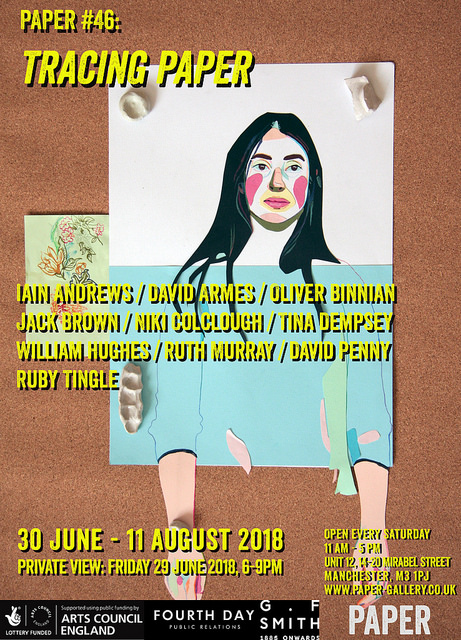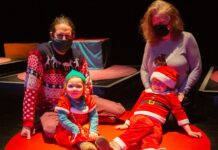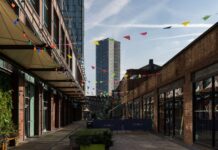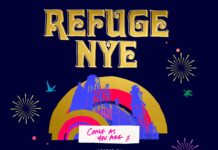After ten months on the Tracing PAPER mentoring scheme, ten incredible artists from the North West will exhibit brand new works based on paper at PAPER.
Running until August 11, the Manchester-based gallery will see each artist exhibit new and unique work developed throughout the period of the mentoring scheme. Tracing PAPER is supported through Arts Council of England’s Grants For the Arts scheme.
Iain Andrews has used Tracing PAPER to explore and create a narrative based on a heady mixture of Faery Tales, related teenage narratives, Goya’s ‘Disaster’s of War’ and Flaubert’s ‘Temptation of St. Anthony’. using ox gall ink on paper. He involves nightmarish figures made from detritus of the studio floor – clay, plasticine and wire, standing in for the demonic presences described by Flaubert and jostling for position with ghosts of the past as they attempt to take on a life on their own in the present. I
David Armes is a dynamic print focussed artist working with language and geography. His work is frequently site-specific and considers how sense and experience of place can be represented. He explores the ways we describe liminal states and how landscape shapes understanding. He works primarily with letterpress printing on paper and in using a once industrial process, he delves into the space where the multiple meets the unique & where the ephemeral meets the archival.
Oliver Binnian is an artist whose practice explores ideas around contemporary versions of the sublime, mediating between real and digital worlds. In absence, the satisfaction of being in a specific place is replaced by a desire and a longing, resulting in a lasting palinopsia. These desires can be partly appeased by digital simulacra such as Google Earth. There is great power in being able to instantly see images from virtually anywhere in the world. In these hyperreal worlds, one sees everything but experiences nothing.
Jack Brown is a socially engaged artist whose work articulates instances of linkage, observation, rumination or pause. His projects bring people together through collective making or thinking. Brown often collaborates, teaches, coordinates, leads public realm projects and facilitates artist networks. His work looks at the overlooked, things that should be given more than a passing glance, moments that would benefit from magnification. Often as a counterbalance to his socially engaged practice Jack’s work plays with ideas of placement, slightness, observation and interaction. Interventions in the wider world, collaborations and manipulations; Brown’s practice can be seen as an investigation into ways of making and how those made objects or moments interact with the world around them. For Tracing Paper Jack will be heading out into Greater Manchester to collect the grease marks left by passenger’s hair on bus windows. Using techniques similar to taking finger prints and through experiments with print making and drawing he will produce a new series of work on paper. These works will talk of human trace and unknowing collaboration, moments collected and re-made.
Niki Colclough’s practice explores a sense of belonging, in the physical and the abstract. Her work is process-led, often collaborative, rooted in the real but leaping into the imaginary. Her current interest is in on-line cultures and how we navigate and make sense of a world that is ever-expanding. For Tracing Paper, she has re-purposed every day actions such as photocopying, filing and sorting to re-order and re-examine this culture, offering the viewer a new way of seeing.
Tina Dempsey’s interdisciplinary creative practice examines the way we look at spaces; social, physical and emotional. Exploring how structure, colour, form and language effects our perception and judgement and sets our cultural landscapes. The dismantling, constructing and re-assembling of information via collage, sculpture and photography, aims to interrupt the semiotic landscape via a series of creative interventions, generating an opportunity for imagery, colour and language to develop new identities and meaning. Works offer the viewer the potential to engage their everyday associations and knowledge of image, language and colour to challenge behavioural attitudes towards ways of seeing and interpreting visual stimuli. By disrupting what is familiar the parameters of function, understanding and value shift allowing the opportunity to create new definitions.
Drawing forms the backbone of William Hughes‘ practice. Images are gathered from a variety of sources; manuals and books, found photo albums and photographs, online and offline image archives.
Reproduced In graphite, the work aims to measure the inertia of the translation process from anonymous image to reproduction on paper against the potentiality of drawing as a meditative, developmental platform. In the recent minature drawings, made throughout the Tracing Paper programme, the spontaneous photograph is both exploited and negated by the drawing process and the associations of the medium. Scaled down and delicately drawn, the images form a loose narrative in which notions of memory, history and the human experience are explored.
The main themes of Ruth Murray‘s practice are the tension of change, the agitation of youth and the feelings of alienation and paranoia associated with misunderstood experiments/rituals. Ruth stages and directs elaborate scenes and then works from photographs of these back at the studio, drawing out and transforming them into something more significant.
Primarily a painter, the scenarios she creates are claustrophobically rich and dreamlike, inviting the viewer into private worlds and states of mind. For the Tracing Paper mentoring scheme Ruth has been focusing on her collage works, developing their function as almost ‘negatives’ of her paintings. A painterly approach to layering is maintained but the images are much more paired down with a focus on form and colour composition.
Using graph paper and basic stationary materials, David Penny has been working on a set of photographic drawings and sculptures. The process involves simple geometric compositions, which are translated through a photographic process. Images are printed back into a grid format where the object merges into the printed surface. The work develops on a practice of using leftovers; studio materials that might otherwise go to waste. This approach is particularly poignant with the imminent closure and demolition of his studio through redevelopment in the area. The objects and diagrams he has made are informed by this new construction visible from where David sits and works. These plans attempt to address an imbalance and offer a new possibility for a place to work.
Ruby Tingle’s practice is primarily concerned with the reconstruction of familiar forms to present and document the extraordinary as authentic. Her works on paper are rooted in natural history and use reassembled cut-out forms to suggest new myths and an alternate folklore. Most recently Ruby has been experimenting with the interaction between these collage forms, either set together as a group within tactile paper landscapes, or in settings comprised of automatic drawing to sound. The forms are also filmed prior to their being fixed into a permanent, physical piece of work, allowing them an animate pre-existence, also posing as evidence of unnatural sightings. She has also begun to use a monochrome colour palette, to reflect the work’s current themes of cryptozoic footage or vintage science fiction; whilst cutting from black & white images is allowing a more abstract and complex carving out process to develop.
Listings Info
PAPER presents: Tracing PAPER
Exhibition dates: 30 June – 11 August 2018
Opening Times: 11am – 5pm every Saturday
PAPER Gallery, Mirabel Studios, 14-20 Mirabel Street, Manchester, M3 1PJ
Website: www.paper-gallery.co.uk
Free







